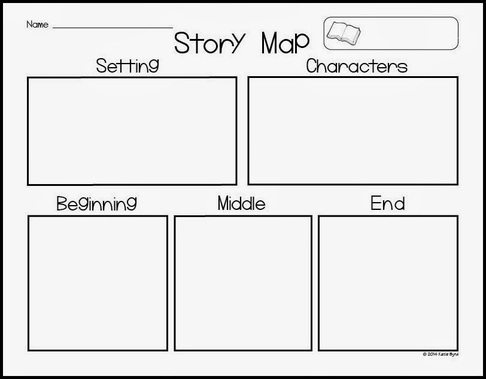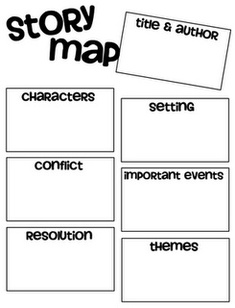Definition:
|
A story map is a strategy that uses a graphic organizer to help students learn the elements of a book or story. By identifying story characters, plot, setting, problem and solution, students read carefully to learn the details. There are many different types of story map graphic organizers. The most basic focus on the beginning, middle, and end of the story. More advanced organizers focus more on plot or character traits (Reading Rockets, 2015).
Story Map ExampleIn this video above, Mrs. Merritt shows an example of what a story map should look like. She goes through step by step instruction on what should be included in a story map. She defines key words such as characters, setting, problem, and solution. She also models what she wrote down in each category so that the students have examples of what each box on her story map should include (i.e. she wrote down the characters from her book she chose to do her story map on). Last she demonstrates how to create a simple story map using a sheet of paper folded into four sections and titles them characters, setting, problem, and solution (Shipman, 2012).
Content AreasLanguage Arts:The example templates above and to the left, demonstrate how story maps are used in reading or language arts. Students identify the setting, characters, the problem, and the solution in the story and write them down in the boxes provided. They can be as simple as begging, middle, end, or then can include plot, setting, characters, and so on.
Math:Story maps can be used to help students solve open-ended math problems. Or students can use the story map to create their own math problems (Reading Rockets, 2015) Social Studies:Using the format of the story map, students can create their own map by taking a walk around the playground or school. Encourage students to include positional words in their story map writing (Reading Rockets, 2015) Differentiated Instruction
Lesson Plan Examples |
Why Use Story Maps?
Steps On How to Use Story Maps In the Classroom
These worksheets above and below are just a few examples of what a basic story map might look like.The video above starts out with the teacher doing a read aloud to give the students the information needed to fill out their story maps. As she reads she points out things such as characters and settings to make sure the students are thinking about what's ahead. In the second part of the video the teacher starts to go over parts of the story maps with the whole group to make sure they know what they are expected to do. In the end the students fill out their story maps on their own.
|
Resources:
Griffith. (2012). Printable Lesson Plan On. Retrieved October 22, 2015, from http://www.teach-nology.com/lessons/lsn_pln_view_lessons.php?action=view&cat_id=4&lsn_id=8635
Jenkins, J. (2013, May 27). 2nd Grade Lesson The Hen and the Apple Tree 1. Retrieved October 22, 2015, from https://www.youtube.com/watch?v=vRzwyTa936c
Shipman, S. (2012, September 19). Story map directions. Retrieved October 21, 2015, from https://www.youtube.com/watch?v=OAxvDLEkI_w
Story Maps. (2015). Retrieved October 21, 2015, from http://www.readingrockets.org/strategies/story_maps
York, M. (2015). [Image]. Story Map. Retrieved October 22, 2015, from https://www.thinglink.com/scene/669598805598928896
(2011). [Image]. Retrieved October 22, 2015, from https://s-media-cache-ak0.pinimg.com/736x/6f/0e/98/6f0e989a60fa84e0ec543e8fd2df0583.jpg
Griffith. (2012). Printable Lesson Plan On. Retrieved October 22, 2015, from http://www.teach-nology.com/lessons/lsn_pln_view_lessons.php?action=view&cat_id=4&lsn_id=8635
Jenkins, J. (2013, May 27). 2nd Grade Lesson The Hen and the Apple Tree 1. Retrieved October 22, 2015, from https://www.youtube.com/watch?v=vRzwyTa936c
Shipman, S. (2012, September 19). Story map directions. Retrieved October 21, 2015, from https://www.youtube.com/watch?v=OAxvDLEkI_w
Story Maps. (2015). Retrieved October 21, 2015, from http://www.readingrockets.org/strategies/story_maps
York, M. (2015). [Image]. Story Map. Retrieved October 22, 2015, from https://www.thinglink.com/scene/669598805598928896
(2011). [Image]. Retrieved October 22, 2015, from https://s-media-cache-ak0.pinimg.com/736x/6f/0e/98/6f0e989a60fa84e0ec543e8fd2df0583.jpg


